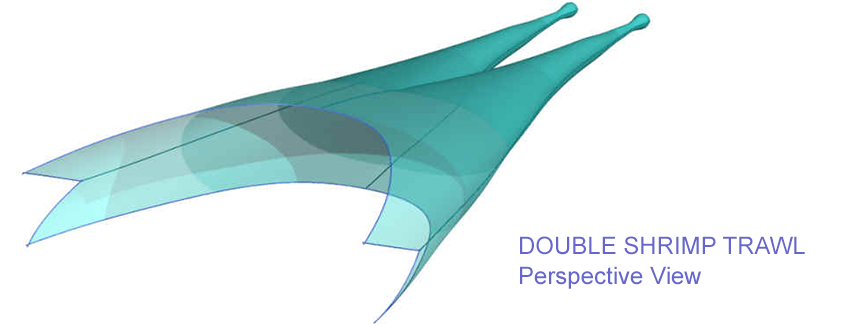Duplex / Triplex Trawls
Duplex & Triplex Trawl Designs from the technical staff at Crimond Enterprises Research & Development
The technical staff at Crimond Enterprises has developed and tested two new trawl designs… the Duplex with two codends, and the Triplex with three codends. The designs are based on the premise that increased footrope swept area; as is the case with twin trawling, can be achieved using a single net.
The new trawls feature a wide horizontal opening for harvesting shrimp or other groundfish species near the bottom. The design also allows a footrope spread area comparable to that achieved by twin trawls, and offers a ‘middle road’ alternative to owners that for financial or technical reasons, are unwilling to convert to twin trawling.




Compared to a single trawl of a given size, the trawl simulation program indicates that it may be possible to achieve a 20% increase in strategic footrope spread area with the Duplex design, and a 47% increase using the Triplex. The horizontal spread or footrope swept area of the new designs compares favourably with data obtained by the technical staff at Crimond Enterprises during a recent successful twin trawling project
This increase in lateral spread justifies the decrease in headline height compared to a single trawl - a 24% decrease for the Duplex, and 32% for the Triplex. There is no requirement to maximize the vertical opening, as is the case for designs targeting roundfish.
Drag does not necessarily increase with multiple codends. Less netting is required in the new designs, compared to that needed for a similar footrope increase in traditional trawls. A single net with one codend and comparable front end geometry would require 30 to 60% more netting.
It is also important to note in the new designs the footrope swept area increase is concentrated in the middle of the net, not in the wings. The wider center area is an advantage when species such as shrimp and flatfish are low and dispersed on the bottom.
With the introduction of the Duplex and Triplex designs, the Crimond Enterprises research and development staff have proven once again that years of industry experience and the latest computer technology can create some of the most innovative fishing gear in the world.
The Concept and Applications of the Wide Body Trawl:
Summary
The technical staff at Crimond Enterprises designed and tested two versions of a unique concept called Wide Body Trawls, one with two codends, and one with three codends. This is an entirely new concept in shrimp trawling and the idea is to provide an alternative between single vessel trawling and twin trawling.
The benefits of twin trawling are well known, and the Crimond's staff have designed and introduced some successful versions of twin trawls. However, some vessel owners are reluctant to spend money on vessel and machinery modifications which are sometimes necessary to conduct a twin trawl operation. They are also apprehensive about operating two trawls simultaneously and would prefer a "middle road" approach.
Traditionally net designs have concentrated on acquiring maximum vertical opening, mainly to harvest round fish species. More emphasis is now being placed on species selective trawls, and when fishing for flatfish there is no requirement for vertical lift, flatfish behavior suggests that horizontal spread is of primary importance. In certain shrimp fishing areas, depending on temperature, shrimps do not rise vertically in the water column but remain distributed near the sea bottom.
These new Crimond designs incorporate increased horizontal parameters and have some definite benefits when compared to a traditional design. For instance the design geometry tends to open the meshes in the codend area and should increase selectivity elements and decrease resistance.
The separation of species into two codends will increase the quality and probably place less tension on the meshes which should make the codend meshes more open and give better selectivity. Less netting material is required and the centre of the net increases considerably. It is important to remember that the footrope increase is concentrated in the middle of the net, not in the wings. Increasing the footrope spread in the centre of the net suggests, that when fishing for certain species such as shrimps, and flatfish, there are definite advantages.
Regarding drag characteristics, it does not necessarily follow that they go up with a two codend arrangement. A single net with similar front end geometry with one codend
An additional plus would be the use of the net as a methodology tool especially in Scottish seining selectivity projects. The fact that the split extends well forward of the extension lends itself to creating an even proportion of species into both codends after they enter the net.
Testing and Evaluation
Scale model tests were conducted in the St Johns Flume Tank in 1997 and the results were positive. Testing was conducted with a variety of towing speeds and rigging arrangements. Drag data was also recorded, together with the net geometry parameters such as door spread, wingend spread, and headline height. The fact that the two comparisons are similar in circumference does not necessarily mean that they will have the same horizontal coverage. An increase of horizontal spread by 20% in the Twin widebody should ensure that the this design of trawl will out perform the single trawl when shrimps are low and spread out.
Click here for link to Report on Duplex / Triplex Trawls in the Great Lakes


